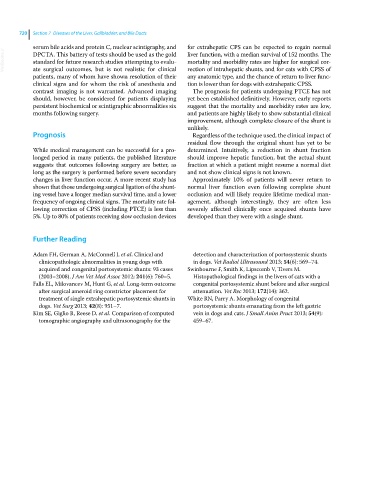Page 752 - Clinical Small Animal Internal Medicine
P. 752
720 Section 7 Diseases of the Liver, Gallbladder, and Bile Ducts
serum bile acids and protein C, nuclear scintigraphy, and for extrahepatic CPS can be expected to regain normal
VetBooks.ir DPCTA. This battery of tests should be used as the gold liver function, with a median survival of 152 months. The
mortality and morbidity rates are higher for surgical cor-
standard for future research studies attempting to evalu-
ate surgical outcomes, but is not realistic for clinical
any anatomic type, and the chance of return to liver func-
patients, many of whom have shown resolution of their rection of intrahepatic shunts, and for cats with CPSS of
clinical signs and for whom the risk of anesthesia and tion is lower than for dogs with extrahepatic CPSS.
contrast imaging is not warranted. Advanced imaging The prognosis for patients undergoing PTCE has not
should, however, be considered for patients displaying yet been established definitively. However, early reports
persistent biochemical or scintigraphic abnormalities six suggest that the mortality and morbidity rates are low,
months following surgery. and patients are highly likely to show substantial clinical
improvement, although complete closure of the shunt is
unlikely.
Prognosis Regardless of the technique used, the clinical impact of
residual flow through the original shunt has yet to be
While medical management can be successful for a pro- determined. Intuitively, a reduction in shunt fraction
longed period in many patients, the published literature should improve hepatic function, but the actual shunt
suggests that outcomes following surgery are better, as fraction at which a patient might resume a normal diet
long as the surgery is performed before severe secondary and not show clinical signs is not known.
changes in liver function occur. A more recent study has Approximately 10% of patients will never return to
shown that those undergoing surgical ligation of the shunt- normal liver function even following complete shunt
ing vessel have a longer median survival time, and a lower occlusion and will likely require lifetime medical man-
frequency of ongoing clinical signs. The mortality rate fol- agement, although interestingly, they are often less
lowing correction of CPSS (including PTCE) is less than severely affected clinically once acquired shunts have
5%. Up to 80% of patients receiving slow occlusion devices developed than they were with a single shunt.
Further Reading
Adam FH, German A, McConnell J, et al. Clinical and detection and characterization of portosystemic shunts
clinicopathologic abnormalities in young dogs with in dogs. Vet Radiol Ultrasound 2013; 54(6): 569–74.
acquired and congenital portosystemic shunts: 93 cases Swinbourne F, Smith K, Lipscomb V, Tivers M.
(2003–2008). J Am Vet Med Assoc 2012; 241(6): 760–5. Histopathological findings in the livers of cats with a
Falls EL, Milovancev M, Hunt G, et al. Long‐term outcome congenital portosystemic shunt before and after surgical
after surgical ameroid ring constrictor placement for attenuation. Vet Rec 2013; 172(14): 362.
treatment of single extrahepatic portosystemic shunts in White RN, Parry A. Morphology of congenital
dogs. Vet Surg 2013; 42(8): 951–7. portosystemic shunts emanating from the left gastric
Kim SE, Giglio R, Reese D, et al. Comparison of computed vein in dogs and cats. J Small Anim Pract 2013; 54(9):
tomographic angiography and ultrasonography for the 459–67.

